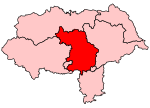The royal Forest of Galtres was established by the Norman kings of England in North Yorkshire, to the north of the Ancient City of York, extending right to its very walls. The main settlement within the royal forest was the market village of Easingwold, but in 1316 the forest comprised 60 villages in 100,000 acres. The Forest of Galtres was intimately connected with York: Davygate in the city was the site of the forest court and prison, a royal liberty within the city of York; Davygate, from which the forest was administered, commemorates David Le Lardiner, whose father, John the Lardiner, was the Royal Lardiner (steward of the larder, in this case providing venison as well as "tame beasts") for the Forest of Galtres, a title which became hereditary in the family.
During the reign of Henry II, the Forest stood at its greatest extent, but by the fifteenth century, concerns were being voiced over the extent of deforestation.Aside from the kings' pleasure in deer hunting, the forest was a dependable source of timber. For the timber palisades of York Castle, which preceded the stone construction of the 13th century, Galfredo de Cumpton, forestario de Gauterio ("forester of Galtres"), was ordered to supply timbers from the Forest to York, to repair the bridge and breaches in the palicium, in 1225.During the Middle Ages, other rights in the royal forests were also valuable, though they conflicted with the preservation of trees. Pannage, the practice of turning out domestic pigs, in order that they may feed on fallen acorns, beechmast, chestnuts or other nuts, was so important that the Domesday Book often valued forest in terms of its capacity to support pigs. The king's foresters collected fees for pannage rights in a typical year, 1319, from pig farmers, at least one of whom was a pork butcher of York. Some appointments were for a lifetime: on 14 June 1626 Charles I granted footfostership, the keepership of the king's deer in Galtres, to James Rosse, with 4d per diem. Defending the valuable traditional rights of the local peasantry to pasturage within the confines of Galtres led to violence against incursions, even ones legitimated by the king's will: a band of forty armed men assembled from five villages threw down enclosures and burned hedges in the Forest of Galtres in the plague year of 1348.Within the Forest of Galtres a motte-and-bailey castle was built at the site of Sheriff Hutton by Ansketil de Bulmer on land given to him by William the Conqueror; it was rebuilt in 1140 by Bertram de Bulmer, Sheriff of York, during the reign of King Stephen The extant remains of the stone-built Sheriff Hutton Castle were built at the western end of the village by John, Lord Neville in 1382–98.The poet John Skelton set his musing dream in "The Garlande of Laurell" (1523), "studyously dyuysed at Sheryfhotton Castell, in the Forest of Galtres", where
From the poem the reader learns that Elizabeth, Countess of Surrey, with the ladies of her household, was living at Sheriff Hutton. At the time it was a seat of her father-in-law the Duke of Norfolk, who was occupied as general-in-chief of an army raised for the invasion of Scotland.It is referred to in Shakespeare's play Henry IV, Part 2 under the anglicised name of "Gaultree Forest".









